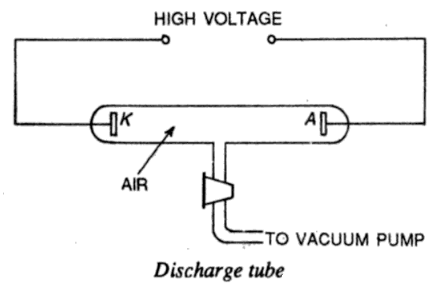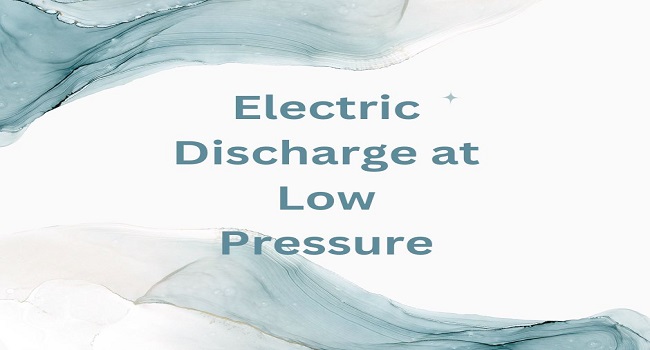Electric Discharge at Low Pressure:
It is a matter of common experience that during thunderstorms large electric sparks jump from the clouds to the ground. The clouds are usually charged with electricity. As soon as the voltage difference between the clouds and the ground becomes large enough, a sudden flow of electricity takes place. A sudden flow of electricity, as in the case of a spark, is called an electric discharge.

An electric discharge can be produced more conveniently in the air if the pressure of the air is reduced. For laboratory studies of the electrical discharges, we, therefore, take special tubes fitted with electrodes and coating gases at low pressures. Such tubes are called discharge tubes.
A typical discharge tube is shown above. It has two electrodes A and K separated by a distance of about 1.5 m and fitted at its opposite ends. The glass tube has a side tube in the middle which can be connected to a vacuum pump and a pressure gauge. A very high voltage of the order of 10,000 V can be applied across the electrodes. The electrode which is connected to the positive terminal of the supply is called anode A and the other electrode connected to the negative terminal is called cathode K. A milliammeter is also connected in the circuit to know the presence of the discharge current.
At atmospheric pressure a voltage as high as 10,000 V fails to produce any current in the milliammeter, showing that air under ordinary circumstances is a bad conductor of electricity, If the experiment is repeated with other gases, similar results are obtained. It is, therefore concluded that all gases under ordinary circumstances are bad conductors of electricity.
The situation is, however, quite different when the experiments are done at low pressures. On reducing the pressure of air gradually in the discharge tube, it is observed that at a certain stage, an electric discharge is suddenly produced in the tube with a crackling sound. The milliammeter in series with the high voltage supply suddenly shows a large deflection. The air is now no more a bad conductor but allows the current to flow.
As the pressure is further reduced, the discharge passes through various stages ultimately and the tube in the region farthest from the cathode begins to glow with faint bluish-green light.









Comments (No)